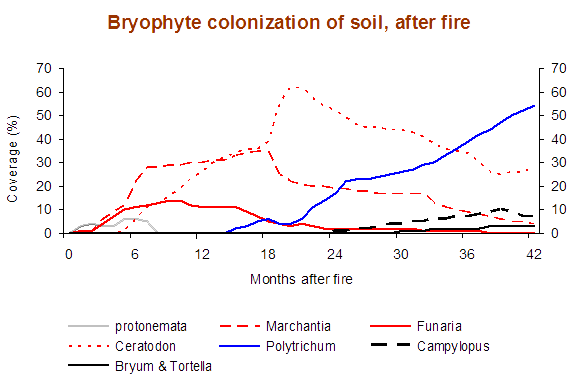Case StudiesTasmania – recolonisation after fireTwo researchers studied several Tasmanian logging coupes. Each had been burnt once as part of the forestry regeneration process. The burning of the coupes was spread over the years 1976-1979. In any given year burning took place in March, before the beginning of the bryophyte growing season. The coupes were sampled four times in the 1979 growing season (between May and October) so that by combining all those samples, from the separate coupes, the researchers had data for post-fire times ranging up to 43 months. The following graph shows estimates of the amount of bryophyte cover on the burnt ground. The horizontal axis shows the time as months after fire. The vertical axes measure percentage of the soil covered. Initially (0 months after the fire) all is bare ground so the bryophyte cover is 0%. Over three and a half years several bryophyte species colonize the area, with their coverages growing or declining, as shown by the several lines.
Very soon after fire the researchers found moss protonemata developing on the soil. The protonemata were not identifiable to genus but, for a few months, such unidentified protonemata formed a noteworthy coverage on the soil and the grey line records this. Three identifiable bryophytes have colonized the area within the first few months after fire. Those three are the thallose liverwort Marchantia berteroana and the mosses Funaria hygrometrica and Ceratodon purpureus. Their changing fortunes are shown by the three red lines. By the end of the first growing season (6 months after fire) Marchantia and Funaria together cover about a third of the area, Marchantia covering a little over 20% and Funaria a little over 10% of the burnt area. Both bryophytes had abundant mature capsules before the start of the second growing season. Marchantia had formed gemmae in gemmae cups by the fifth month after the fire and it's likely that in the first year after the fire Marchantia spread mostly by gemmae. You can see that though Ceratodon had appeared by the end of the first growing season, there was a dramatic increase in Ceratodon cover in the second six months and a doubling during the second year after fire, with Ceratodon peaking to cover a little over 60% of the area. As Ceratodon coverage has been peaking that of Marchantia and Funaria has been dropping. By the end of the second year after the fire Ceratodon coverage is also declining but now Polytrichum juniperinum (the blue line) is well established and on it's way to becoming the dominant bryophyte. At the end of the 42nd month this Polytrichum species covered about 55% of the ground. By this time some other mosses had also made readily noticeable appearances (three species of the genus Campylopus, mostly Campylopus introflexus, as well as Bryum sauteri and Tortella calycina ), as shown by the black lines. Burnt ground accounted for about 30% of the surface in the study area, the rest being charred wood, burnt tree ferns and rocks. Those substrates were colonised more slowly than the burnt ground and not as extensively. Ceratodon purpureus was consistently the most prominent species. The leafy liverwort Cephaloziella exiliflora became conspicuous on the charcoal surfaces of burnt wood during the third year. The researchers recorded the bryophyte species in the unburnt areas alongside the burnt coupes. The bryophyte flora in those areas should have been fairly representative of the pre-fire bryophyte flora in the burnt coupes. In those adjacent, unburnt areas 34 moss and 28 liverwort species were recorded as common, though by no means the only bryophytes to be found there. What is interesting is that none of the colonizing, post-fire species, mentioned above, featured in that list of common bryophytes from the adjacent unburnt areas. Reference
|
![An Australian Government Initiative [logo]](/images/austgovt_brown_90px.gif)


